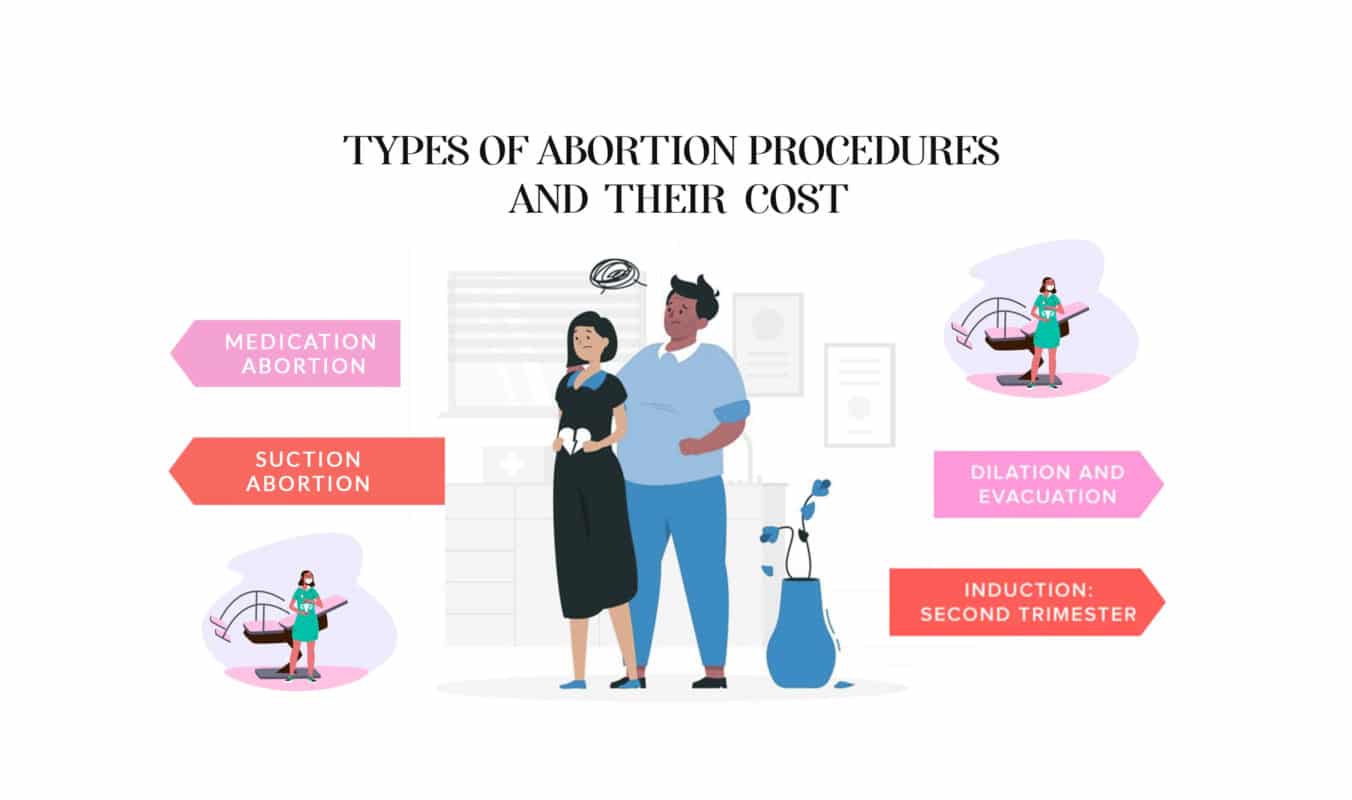How Much Does An Abortion Cost?

With the erratic future of the reproductive rights of women, abortion costs vary greatly in the United States. Deciding to end a pregnancy can have a great emotional toll on you, and to add to it, the monetary apprehensions. There are so many factors that go into deciding the cost of it, namely the local laws of the governing bodies, duration of your pregnancy, type of procedure you would have to undergo, and of course, whether it will be covered with insurance.
When you google the cost of abortion, you may get overwhelmed by the displayed numbers on your screen. From zero dollars to over 10,000 dollars, the cost of an abortion varies significantly. And even more so for abortion under hostile conditions. Around 50% of the women who opt for abortion in the States belong to the places where it’s the hardest to access.[1] Studies show that more than half of the women who decide to terminate their pregnancy already have kids.[2] This increases the cost of abortion when they have to take time off from their work and find a childcare service to make it to the appointments.
Table of Contents
Factors Determining The Prices For Abortion

- Place of Residence: Laws regarding abortion vary significantly from state to state and keep on changing with modifications to federal laws. Some states legalize abortion, while others have extremely strict guidelines on how and when the procedure can be done. Stricter the guidelines, the higher the cost.
- Duration of Pregnancy: There are options available for abortion up to 10 weeks of pregnancy which fall between invasive and non-invasive categories.[3] After the completion of 10 weeks, doctors most probably suggest surgical procedures to physically remove the uterine contents. An abortion at 6 weeks of pregnancy will cost you less than an abortion at 20 weeks. Further along, you are in pregnancy, more will be the cost of abortion due to additional procedures that need to be carried out.
- Type of Procedure: Medicated termination of pregnancy costs less than a surgical procedure.[4]
- Scope of Insurance: Whether or not insurance will bear the expenses of your abortion depends on the coverage plan. Some government health insurance schemes support abortion, while others do not. Since 2010, the cost of abortion coverage by insurance companies has been restricted in 26 states, while 11 states have restricted private insurance plans. Access to abortion coverage by insurance has been restricted for public employees by 22 states.[5]
Types of Abortion Procedures and Their Cost

What type of procedure can be done to terminate your pregnancy depends on how far along you are. Usually, for the first 10-12 weeks, pregnancy can be terminated by the use of medications and/or abortion by aspiration.[3] After 10 weeks of pregnancy, abortion is usually conducted by dilation & evacuation procedure. The possibility of you getting an abortion gets dimmer with the progress of your pregnancy.
(Suggested further read – When Is It Too Late To Get An Abortion)
Medication Abortion
Abortion is an easier option to obtain, especially now that it’s available through telemedicine in some states as kits such as MTP Abortion Kits. The procedure resembles that of a natural miscarriage and is less invasive. However, it is only administrable for five to ten weeks of pregnancy. Even though it is very rare for the pills not to work or cause any complications, there is a risk, and then you would have to undergo an additional procedure.
Process:
- This procedure uses a combination of two medications, namely RU-486, which contains the active ingredient Mifepristone, and Cytotec 200 mcg, which has Misoprostol as the active ingredient.
- You would be required to take one pill of Mifepristone orally in the presence of a healthcare worker and, within 24-48 hours, 4 tablets of the Misoprostol, either in the buccal pouch or vaginally. The exact time to take the pills will be communicated to you by your healthcare provider.
- For oral consumption, insert the pills into your cheek pouch (between the cheek and gums) till they get absorbed completely.
- For vaginal insertion, lay down and insert the tablets in your vagina. If they come out before the bleeding starts, you need to put them back. If the tablets pass out along with bleeding, you don’t need to worry, as most of the medication would have been absorbed by then.
- You will start feeling heavy cramping and bleeding within 1-5 hours of the use of misoprostol tablets.
- The removal of fetal tissue from the body takes around 1-5 hours, but you will have bleeding and cramping for a few days.
- You would be required to follow up with the doctor to confirm that you are no longer pregnant.
the cost of an abortion pill you’ll have to bear depends on your insurance and the place you are going for the treatment. The cost of medicated abortion may range anywhere from 80$ to over 1500$. Because of more awareness among the people and the experience with medication that demonstrated no adverse effects to the recipients, the cost of the medications is coming down, with the mean cost being around $504.[4] You can get access to abortion pills at abortion centers or even buy them online.
Suction Abortion
Also known as aspiration abortion is usually conducted for pregnancy between 5 to 14 weeks but can be used for later cases. Its expenses range between $ 450 to $1000. Abortion costs without insurance coverage may add up to $1500.
Process:
- You will be given anesthesia before the procedure.
- The doctor will use a small instrument, known as manual vacuum aspiration, to remove the contents of your uterus.
- The process takes around 5 – 10 minutes. However, you will be required to stay at the clinic under supervision for a few hours.
- Then doctors prescribe pain medication and antibiotics before discharging you at home.
This procedure is considered relatively safer and with a success rate than a medication abortion, and it also has milder symptoms of cramping and bleeding.[5]
Abortion by Dilation & Evacuation
D&E procedures are carried out for termination of pregnancy in the late first trimester and the second trimester and is considered safest for use after the 10-week mark. The genetic assessment of the fetus is usually carried out after the completion of 12 weeks, which makes this procedure a preferred choice if any abnormalities are found. However, it is an expensive procedure and may cost you between $500 to $3000 or even more. This procedure may not be accessible in certain states and takes more time.
Process:
Second-trimester abortion costs are higher than the first-trimester procedures, particularly because of the additional measures that are executed, such as abortion injection costs, abortion pills costs, etc. As the pregnancy proceeds, the cervical membranes grow thicker. To allow fetal tissue removal, the cervix must be dilated before the actual detachment of fetal tissue can be accomplished.
- The cervix is dilated with the help of either an osmotic dilator or by use of misoprostol.
- Osmotic dilators are synthetically made thin rods that are inserted into the cervical opening. These dilators open the cervix by expanding over a while by absorbing the moisture. You will feel cramping when your cervix starts dilating.
- Misoprostol is a prostaglandin that dilates the cervix. The misoprostol tablets are usually placed in the buccal cavity or can be inserted in the vagina as well. You may experience nausea, cramping, chills, or fever.
- For a pregnancy that has exceeded 20 weeks, both osmotic dilators and misoprostol are used. In addition, an injection (intravenous oxytocin injection) is administered in the abdomen to arrest fetal growth and ensure its demise before the procedure.
- You will be provided with local anesthesia in addition to strong painkillers before the start of the procedure. The doctor may as well use an instrument to dilate your cervical opening further.
- Then, with the use of a vacuum aspirator and other instruments, your doctor will remove the placental and fetal tissue.
Late Abortions

Late abortions refer to the pregnancy termination procedures that are carried out in later stages, such as the third trimester. It is an expensive procedure because of the array of medical protocols that are required to be conducted.
- In certain cases, labor is induced to terminate the pregnancy and make your uterus contract so that the contents can be passed out.
- In some cases, a modified version of the dilation & evacuation procedure is implemented.
- Usually, the doctors combine both labor induction and D&E procedures to terminate the pregnancy.
These procedures are usually undertaken when there’s a serious threat to pregnancy but are often executed without any major complications under proper provisions. Late abortions, however, can be extremely expensive, ranging over $8000, and not many states allow such procedures.
What To Do When You Cannot Afford An Abortion?
Abortion fees in designated abortion clinics are calculated based on the income scale. There are usually a group of people who analyze everything to find out the best affordable option for you. Moreover, there are resources such as the National Network of Abortion Funds in every state that can help fund an abortion if you cannot afford it. The abortion clinic costs are not covered by insurance programs run by federal and state governments in many states unless it is a rape, incest, or life-threatening case.
To Conclude – Is Abortion Expensive?

The average cost of a surgical abortion in California is $750, medical abortion costs around $700 for the earlier durations (less than 12 weeks). And a D&E procedure can set you back $1000-$3100. With all the stress and anxiety around the actual process and its after-effects, it is crucial to know how expensive abortion can be to choose the correct procedure for yourself. The price of abortion will rise as the pregnancy proceeds. If you have decided to end the pregnancy, it is crucial to make an appointment at the earliest to discuss the options available to reduce the chances of any complication or increased financial burden.
____________________________________________________________________
References
- Jones RK, Ingerick M, Jerman J. Differences in Abortion Service Delivery in Hostile, Middle-ground, and Supportive States in 2014. Womens Health Issues. 2018 May-Jun;28(3):212-218. doi: 10.1016/j.whi.2017.12.003. Epub 2018 Jan 12. PMID: 29339010; PMCID: PMC5959790. https://pubmed.ncbi.nlm.nih.gov/29339010/
- Induced abortion in the United States (2022) Guttmacher Institute. https://www.guttmacher.org/fact-sheet/induced-abortion-united-states#
- Kulier R, Kapp N, Gülmezoglu AM, Hofmeyr GJ, Cheng L, Campana A. Medical methods for first trimester abortion. Cochrane Database Syst Rev. 2011 Nov 9;2011(11):CD002855. doi: 10.1002/14651858.CD002855.pub4. Update in: Cochrane Database Syst Rev. 2022 May 24;5:CD002855. PMID: 22071804; PMCID: PMC7144729. https://www.ncbi.nlm.nih.gov/pmc/articles/PMC7144729/
- Sanchez-Morales JE, Rodriguez-Contreras JL, Ruiz-Lara L, Ochoa-Torres B, Zaragoza M, Padilla-Zuniga K. Cost Analysis of Surgical and Medical Uterine Evacuation Methods for First-Trimester Abortion Used in Public Hospitals in Mexico. Health Serv Insights. 2022 Sep 23;15:11786329221126347. doi: 10.1177/11786329221126347. PMID: 36171763; PMCID: PMC9511298. https://www.ncbi.nlm.nih.gov/pmc/articles/PMC9511298/
- Medical vs. surgical abortion (no date) UCLA Health System. https://www.uclahealth.org/obgyn/medical-versus-surgical-abortion
Disclaimer
HisBlue is not a substitute for professional medical care or advice from your doctor. The health information on the HisBlue website is general and provided for your information only. We have ensured our content is accurate and current, with reviews by expert doctors. However, we cannot guarantee its accuracy or timeliness. This information is not meant to replace the diagnosis, treatment, or judgement of your doctor or another qualified healthcare provider.


